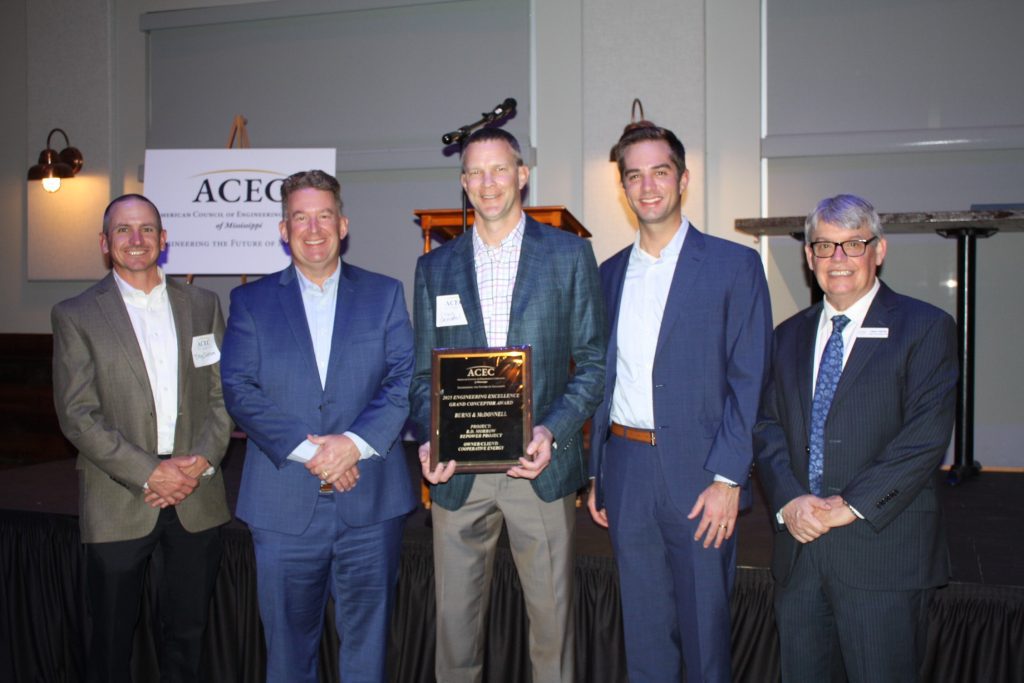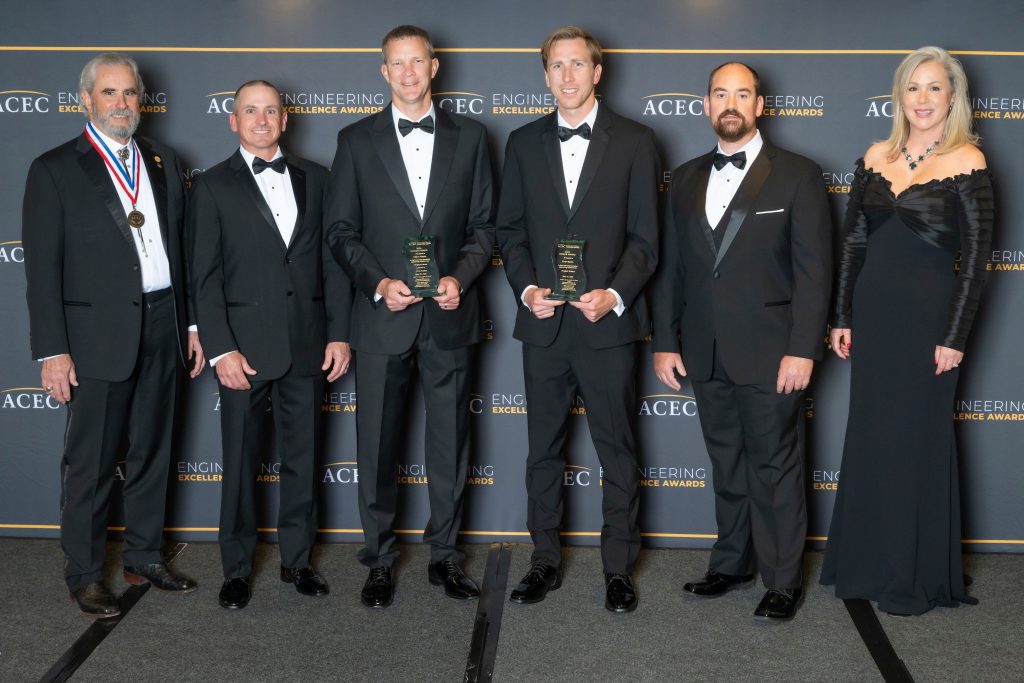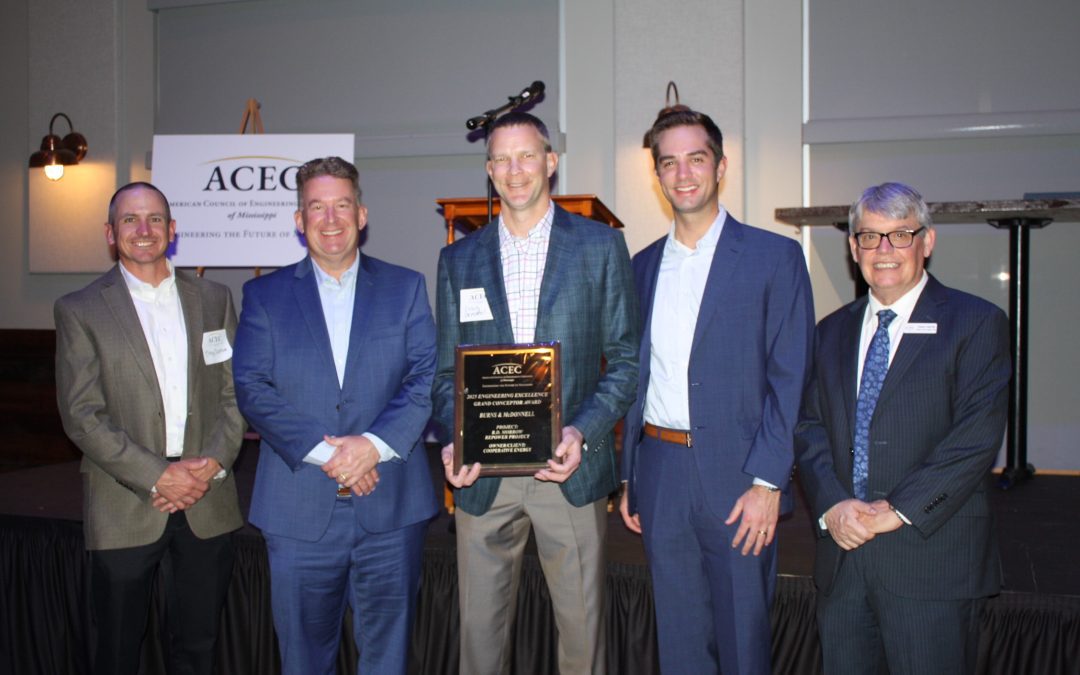
(Left to right) Trey Cannon, Cooperative Energy director of generation projects; Mark Smith, Cooperative Energy senior vice president of power generation; Craig Demmel, Burns & McDonnell project manager; Craig Carter, American Council of Engineering Companies of Mississippi executive director.
Cooperative Energy, Mississippi’s generation and transmission cooperative, and partner Burns & McDonnell recently earned state and national recognition for engineering excellence for the Morrow Repower Project. The project increased the generating capacity and reliability of the R.D. Morrow, Sr. Generating Station in Purvis.
The two teams garnered the state’s top award, the Grand Conceptor Award, from the American Council of Engineering Companies of Mississippi in the spring. The project was then recognized as one of the top 24 engineering projects in the nation at the American Council of Engineering Companies’ 58th annual Engineering Excellence Awards where it earned a national Honor Award for exemplary engineering
Burns & McDonnell oversaw the design, procurement, and construction of the advanced gas turbine and heat recovery steam generator that transformed the unit into the most efficient repowered facility in North America, capable of producing 550 MW of electricity.
The new plant operates on the site of the Cooperative’s legacy 1978 coal facility. In June 2018, the Cooperative Energy Board of Directors announced a five-year plan to convert the plant from coal to natural gas due to improved efficiency and economic factors. As a not-for-profit, Member-owned electric utility, responsibility, reliability, and affordability were deciding factors for the project.
Now complete, the plant generates more electricity more economically and provides the operational flexibility necessary to balance the increase in renewable energy sources across the country. Transitioning from coal to natural gas also halved its carbon footprint. The Morrow Repower Project signifies Cooperative Energy’s commitment to reliability, sustainability, and economic efficiency.
The project involved meticulous planning, demolition of aging coal boilers, reutilization of the existing cooling tower and steam turbine, and integration of advanced-class Siemens 9000HL combustion turbine technology. The Morrow Repower Project delivers tangible benefits for Mississippi communities, including cleaner energy, increased efficiency, and reduced operational costs.

(Left to right) Gary Raba, American Council of Engineering Companies board chair; Trey Cannon, Cooperative Energy director of generation projects; Craig Demmel, Burns & McDonnell project manager; Will Graham, Burns & McDonnell mechanical engineer; Jeff Pitts, Cooperative Energy Plant Morrow superintendent; and Linda Bauer Darr, American Council of Engineering Companies president & CEO.
“The new Plant Morrow represents forward-thinking energy solutions for our distribution Members at a competitive price,” said Cooperative Energy’s Senior Vice President of Power Generation Mark Smith. “We’re honored that the state and national engineering communities recognize the integrity and value of this project and how it will continue to benefit more than 1 million Mississippians for decades to come.”
Judging for the awards program was conducted by a national 32-member panel of environmental leaders and experts from government, media, and academia. Award criteria focused on uniqueness and originality, technical innovation, social and economic value, and generating excitement for the engineering profession.
The teams were recognized at the Engineering Excellence Awards Gala at the Grand Hyatt in Washington, D.C.
SIDEBAR:
Project details:
- MISO is now controlling and dispatching the baseload unit.
- Plant is powered by Siemens 9000HL advanced-class combustion turbine technology paired with an existing steam turbine.
- The plant uses a heat-recovery power strategy that utilizes the thermal power from the new gas turbine in existing plant thermal systems. This enables the plant to achieve the efficiency of new combined-cycle plants and reduce its previous carbon footprint by half.
- The project reduces Cooperative Energy’s carbon footprint by more than 2 million tons of CO2 per year.

